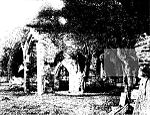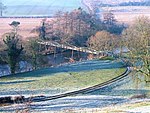Sockburn

Sockburn is a village and former civil parish, now in the parish of Neasham, in the Darlington district, in the ceremonial county of Durham, England. It is situated at the apex of a meander of the River Tees, to the south of Darlington, known locally as the Sockburn Peninsula. Today, all that remains of the village is an early nineteenth-century mansion, a ruined church and a farmhouse built in the late eighteenth century.Sockburn is best known for: Important links with Lindisfarne and Celtic Christianity The discovery of Viking Age hogbacks. The Sockburn Worm , a ferocious wyvern that in folklore laid waste to the village. Sockburn Hall, a 19th-century country house and a Grade II listed building.
Excerpt from the Wikipedia article Sockburn (License: CC BY-SA 3.0, Authors, Images).Sockburn
Sockburn Lane,
Geographical coordinates (GPS) Address Nearby Places Show on map
Geographical coordinates (GPS)
| Latitude | Longitude |
|---|---|
| N 54.46173 ° | E -1.46397 ° |
Address
Sockburn Lane
Sockburn Lane
DL2 1PH
England, United Kingdom
Open on Google Maps









